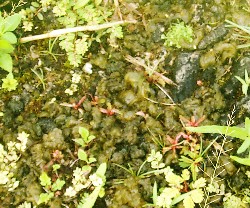 Balls of green jelly found on rocky ground in the sun.
Balls of green jelly found on rocky ground in the sun.1. ____
L1 name:
Local use:
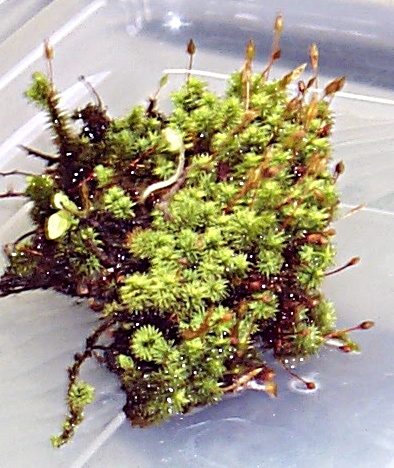 Found on rocks near rivers, on tree trunks, and in the shade.
Found on rocks near rivers, on tree trunks, and in the shade.2. ____
L1 name:
Local use:
Place the letter for the correct name of the plant under the picture of the plant. Write the name in your first language (L1), if any. Your language might no longer have a name for the plant. If so, then leave the item blank. Write down a use for the plant in Micronesia. The use can be from any culture.
A. Asplenium nidus D. Moss B. Cyanobacteria E. Phymatosorus scolopendria C. Lycopodium cernuum F. Thelypteris maemonensis
 Balls of green jelly found on rocky ground in the sun.
Balls of green jelly found on rocky ground in the sun.1. ____ L1 name: Local use: |
 Found on rocks near rivers, on tree trunks, and in the shade.
Found on rocks near rivers, on tree trunks, and in the shade.2. ____ L1 name: Local use: |
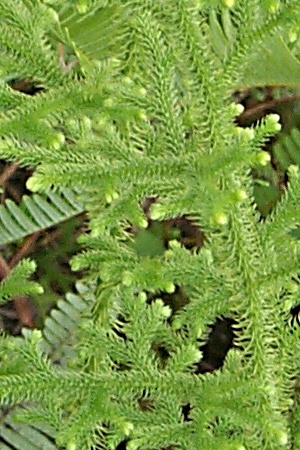 Fuzzy almost furry plant found on sunny hilltops beyond the gym.
Fuzzy almost furry plant found on sunny hilltops beyond the gym.3. ____ L1 name: Local use: |
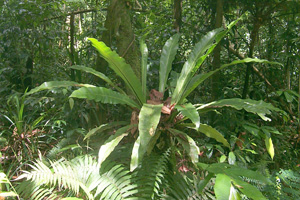 Usually found growing on trees.
Usually found growing on trees.4. ____ L1 name: Local use: |
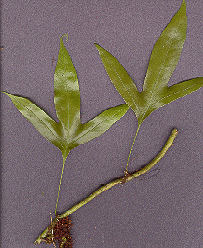 Found growing on trees, including coconut palms. Also grows on the ground.
Found growing on trees, including coconut palms. Also grows on the ground.5. ____ L1 name: Local use: |
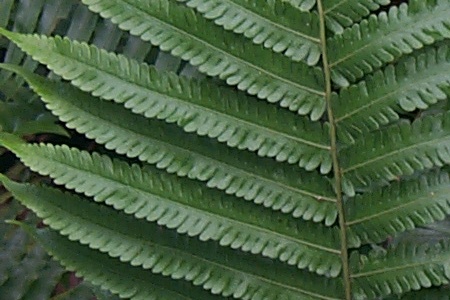 Found growing on the shady forest floor.
Found growing on the shady forest floor.6. ____ L1 name: Local use: |
As best as you can, match the word to the language or language subgroup
|
07. _____ Asplenium nidus 08. _____ Bird's nest fern 09. _____ chath 10. _____ kardoap 11. _____ lo'goho 12. _____ muhlihklihk 13. _____ nük 14. _____ tehnlik 15. _____ toahnlik |
A. Chuukese B. English C. Kapinga D. Kosraen E. Kitti F. Latin G. Mwoakillese H. Pohnpeian I. Yapese |
 In the image of the moss to the right, what is the function of the long stalks that come up from the moss and end in a capsule? We viewed these in the laboratory on Tuesday. On living moss the stalks and capsule are usually brown.
In the image of the moss to the right, what is the function of the long stalks that come up from the moss and end in a capsule? We viewed these in the laboratory on Tuesday. On living moss the stalks and capsule are usually brown.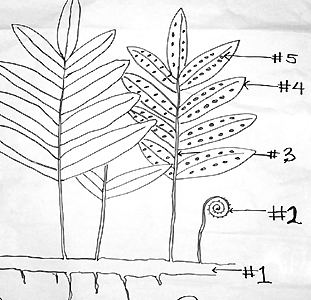 #1: ______________
#1: ______________On page fifty-three of our text Dr. Balick notes that "This triad of immobility, carbohydrate production, and diverse biochemistry makes plants far more useful to human beings than animals can be." Lecture has also covered the impact of immobility and biochemistry on the importance of plants. Write a short essay explaining this triad, both the meaning of the three terms and how they relate to making plants important to people.